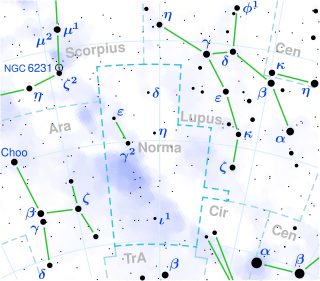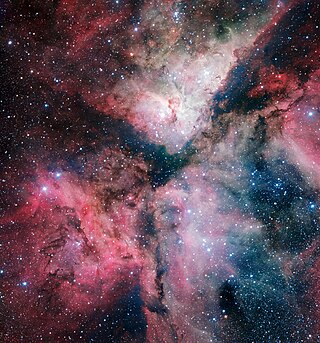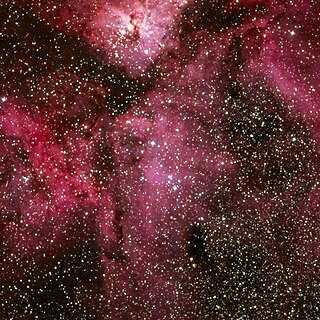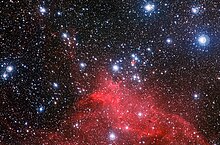
V399 Carinae is a variable star in the constellation Carina.

V382 Carinae, also known as x Carinae, is a yellow hypergiant in the constellation Carina. It is a G-type star with a mean apparent magnitude of +3.93, and a variable star of low amplitude.

HD 96919, also known by its Bayer designation of z2 Carinae and the variable star designation of V371 Carinae, is a blue supergiant star in the constellation Carina. It lies near the Carina Nebula and at a comparable distance.

DL Crucis is a variable star in the constellation Crux.

μ Normae, Latinised as Mu Normae, is a blue supergiant star of spectral type O9.7 Iab, located in the constellation of Norma.

RT Carinae, also known as CD-58 3538, is a variable star in the Carina Nebula in the constellation Carina. It has a mean apparent magnitude of +8.55.

V424 Lacertae is a red supergiant variable star in the constellation Lacerta. It is a member of the Lacerta OB1 stellar association.

WR 24 is a Wolf-Rayet star in the constellation Carina. It is one of the most luminous stars known. At the edge of naked eye visibility it is also one of the brightest Wolf Rayet stars in the sky.

KQ Puppis is a spectroscopic binary variable star in the constellation Puppis. A red supergiant star and a hot main sequence star orbit each other every 9,742 days. Its apparent magnitude varies between 4.82 and 5.17.

V1073 Scorpii is a variable star in the constellation Scorpius. It has a non-Greek Bayer designation of k Scorpii. The star has a blue-white hue and is visible to the naked eye with an apparent visual magnitude that fluctuates around +4.87. Parallax measurements yield a distance estimate of approximately 2,920 ly (896 pc) from the Sun, and it is drifting further away with a radial velocity of +7 km/s. It has an absolute magnitude of −6.8

10 Persei is a blue supergiant star in the constellation Perseus. Its apparent magnitude is 6.26 although it is slightly variable.

3 Geminorum is a blue supergiant star in the constellation Gemini. It is a small amplitude pulsating variable and a close double star, with a mean combined apparent visual magnitude of about 5.7.

V520 Persei is a blue supergiant member of NGC 869, one of the Perseus Double Cluster open clusters. It is an irregular variable star. At a magnitude of 6.55, V520 Persei is the brightest member in either NGC 869 or NGC 884, although the brighter HD 13994 lies in the foreground along the same line of sight.

HR 4887 is a suspected variable star in the open cluster NGC 4755, which is also known as the Kappa Crucis Cluster or Jewel Box Cluster.

DS Crucis is a variable star near the open cluster NGC 4755, which is also known as the Kappa Crucis Cluster or Jewel Box Cluster. It is in the constellation Crux.

BU Crucis is a variable star in the open cluster NGC 4755, which is also known as the Kappa Crucis Cluster or Jewel Box Cluster.

V528 Carinae is a variable star in the constellation Carina.

BO Carinae, also known as HD 93420, is an irregular variable star in the constellation Carina.

DU Crucis is a red supergiant and slow irregular variable star in the open cluster NGC 4755, which is also known as the Kappa (κ) Crucis Cluster or Jewel Box Cluster.

Collinder 228 is an open cluster within the southern part of the Carina Nebula NGC 3372, about 25' south of η Carinae. It is probably composed of stars which recently formed from the material in the nebula. QZ Carinae is the brightest member of Collinder 228 with an apparent magnitude between 6.16 and 6.49.


















